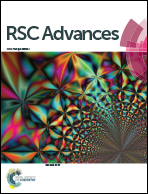Facile synthesis of magnetic nanocomposites of cellulose@ultrasmall iron oxide nanoparticles for water treatment
Abstract
We report a facile in situ approach to synthesize magnetic nanocomposites of cellulose@ultrasmall iron oxide nanoparticles by co-precipitation using ionic liquid as co-solvent for cellulose and iron salt. The as-prepared γ-Fe2O3 nanoparticles showed ultrasmall particle size (∼4.6 nm) and uniform distribution (the standard deviation is less than 10%). The magnetic nanocomposites displayed excellent adsorption efficiency for Pb(II) and methylene blue compared with other reported magnetic materials. The adsorption capacities of the magnetic nanospheres for the removal of Pb(II) and methylene blue were 21.5 and 40.5 mg g−1, respectively. Furthermore, the prepared magnetic nanoadsorbent could be efficiently recycled and reused by applying an external magnetic field. The approach presented in this paper promotes the use of renewable natural resources to prepare a variety of hybrid inorganic–organic materials for the purpose of adsorbents, biomedical and other potential applications.


 Please wait while we load your content...
Please wait while we load your content...